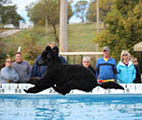Fact Sheet
IDIOPATHIC EPILEPSY (IE)
Toy, Miniature, & Standard.
Idiopathic epilepsy (IE) refers to seizures that are not due to an identifiable cause such as one of the following: metabolic disorder (for example, liver disorders, hypoglycemia), infectious diseases that affect the brain and central nervous system (for example, distemper, toxoplasmosis), tumors, exposure to poisons, severe head injuries, etc. When seizures are due to any of these other factors, the dog is considered to have “symptomatic epilepsy” because the seizures are “symptoms” of another disorder. With IE, a thorough diagnostic workup reveals no other disorders that could be causing the seizures.
There are many different kinds of seizures that can occur with idiopathic epilepsy (IE). It is helpful to distinguish between generalized and focal seizures. Generalized seizures involve both hemispheres (halves) of the brain at the same time, and they often are called “grand mal” (meaning “big illness”) seizures because they are very dramatic. The dog is likely to fall over and either be very stiff or shaking all over, or both. Many dogs drool or foam at the mouth, and some dogs lose bladder and/or bowel control. During generalized seizures, dogs are not able to respond to their owners because they are completely unconscious.
In contrast, focal seizures (also called “partial” seizures because they only involve part of one hemisphere of the brain) are less dramatic and often are not recognized by owners or veterinarians as seizures. Focal seizures can include rigidity and/or shaking of only part of the body (for example, only the head, or hind end, or one leg), staggering while walking as if drunk, snapping or biting at imaginary flies, running in a frantic and disoriented fashion as if being chased, hiding for no reason (often in the bathroom or under a table), drooling and mildly shaking, etc. Dogs often do not respond normally to their owners during a partial seizure; they may appear to be confused or disoriented. However, they are not completely unconscious.
A common occurrence in Poodles is for a seizure episode to begin as a focal seizure, but progress into a generalized seizure. Sometimes, the progression is pretty clear to someone watching. For example, there may be twitching or jerking of one body part that gradually increases in intensity and progresses to include the entire body.
However, often a focal seizure progresses into a generalized seizure so quickly that many people only pay attention to the generalized part of the episode. For example, if a dog drools or vomits shortly before falling over and having a generalized seizure, this is an indication that the seizure began in only one part of the brain (which caused the drooling or vomiting), but quickly spread to the rest of the brain. Another example of an episode beginning as a focal seizure but quickly generalizing, is when a dog seeks the owner’s attention and/or shows clear signs of fear or confusion right before falling over into a generalized seizure.
Often different kinds of seizures run in different bloodlines. For example, in some bloodlines that are affected by IE, seizures tend to be more severe and occur in “clusters” with more than one seizure occurring in the same day. However, different kinds of seizures can also occur within the same bloodline, even within the same litter.
At the time of this writing (January, 2009), the genes responsible for idiopathic epilepsy (IE) have not been identified for any breed. However, there is strong scientific evidence that IE is inherited as an autosomal recessive trait in Poodles and several other breeds. This means that if a dog or bitch is affected with IE, both the sire and dam must have passed down the genetic defect. It is not necessary that either parent have seizures himself or herself, as one or both parents may be a “carrier.” With autosomal recessive traits, a “carrier” possesses only one copy of the genetic defect, whereas an “affected” dog or bitch possesses two copies of the genetic defect. The one published scientific study on the mode of inheritance of IE of Poodles examined a very large family of Standard Poodles (data was available on 90 Poodles) and found that the pattern of inheritance of IE was most consistent with a “simple” autosomal recessive trait. The term simple means that only one gene pair is responsible for IE. However, until the actual gene (or genes) is discovered, one cannot be absolutely certain whether there is only one gene responsible for the disorder or whether IE is inherited with a more complex pattern of inheritance.
For a more detailed discussion of the data suggesting a simple autosomal recessive mode of inheritance for IE in Poodles, the reader is referred to Licht, et al, in the Journal of the American Veterinary Medical Association, November 15, 2007, volume 231, pages 1520-1528.
A thorough diagnostic workup is recommended in order to rule out a wide variety of factors that can cause seizures. The workup should include:
- Complete physical examination
- Neurological examination (testing reflexes, coordination, cranial nerve responses, limb strength, etc.)
- Complete blood count
- Serum chemistry profile (after 12-hour fast)
- Urinalysis
- Test of liver function, such as 12-hour fasting and 2-hour postprandial (post-snack) bile acids
- Tests for any suspected poisons (for example, lead from chewing old paint chips or linoleum)
- Tests for specific infectious diseases (for example, Lyme disease, toxoplasmosis) that may be suspected due to the dog’s particular history
- Thyroid panel
Additionally, owners should carefully describe the seizure episode(s) to the veterinarian and report any neurological signs that occur in between seizures (for example, head tilt, unusual gait, impaired vision, restlessness, irritability, hiding, loss of housetraining, unusual vocalization). Additional testing (such as brain imaging, cerebral spinal fluid tap, x-rays, electroencephalogram) may be recommended if the dog shows abnormal findings on any of the above or if idiopathic epilepsy seems unlikely due to the dog’s age and/or history. When a thorough diagnostic workup reveals nothing abnormal, then the dog is diagnosed as having idiopathic epilepsy. That is, IE is a diagnosis based on exclusion of all other likely causes of seizures.
The most common age of onset for idiopathic epilepsy (IE) in dogs is 1-5 years of age. However, many cases of IE do emerge as young as 6 months and as old as 7 years of age.
For some dogs with idiopathic epilepsy (IE), the seizures will be sufficiently infrequent (one or two per year) that no treatment is required, unless the seizures are extremely long or occur in “clusters” (two or more seizures in a 24-hour period). Currently, there is no consensus concerning when treatment should begin. Many veterinarians suggest that treatment should begin if the dog or bitch is having at least one seizure per month. However, others suggest that treatment should begin much sooner (for example, if the dog is having one seizure every 3 months).
Some research suggests that the long-term prognosis is better when the individual begins treatment before the seizures become too frequent. This is because the brain seems to “get used to” having seizures, which makes the seizures more difficult to control when you do start treatment. Thus, owners should work closely with a veterinarian who is knowledgeable about research on IE when making the difficult decision of when to start treatment.
For those who require treatment, there are two very good anticonvulusant (anti-seizure) medications that are very effective with dogs: Phenobarbital (PB) and Bromide. Bromide is either administered as Potassium Bromide (KBr) or Sodium Bromide (NaBr). For decades, Phenobarbital was the first medication of choice, and KBr was either added or substituted when a dog/bitch did not respond well enough to Phenobarbital or when a patient had liver problems. Phenobarbital can cause liver problems, although regular liver monitoring (every 6 months) will generally catch problems before they become serious. However, some veterinarians prefer to use KBr first because it does not cause liver problems, although KBr may increase the risk of pancreatitis.
Regardless of which medication is used, it is important to regularly monitor the level of medication in the animal’s blood to determine if the blood level is within the “therapeutic range” (that is, high enough to control seizures, but not too high to cause serious side effects). Although there are many other drugs that are effective at controlling seizures in humans, most of these are less effective with dogs/bitches because the canine liver metabolizes them too quickly. They also are more expensive than either Phenobarbital or Bromide. Nonetheless, if neither Phenobarbital nor Potassium Bromide works well, there are some other alternatives that work very well with many dogs such as Zonisamide (Zonegran) or Levetiracetum (Keppra).
After an individual has been completely seizure-free for two or more years, it may be possible to SLOWLY wean the dog/bitch off medication or at least lower the dosage significantly. The ones who are most likely to be successful are those who showed a fairly quick reduction or elimination of seizures in response to medication when it was first begun.
A number of owners and veterinarians prefer to try non-traditional (“alternative”) approaches to controlling seizures. These include diets, herbal remedies, acupuncture, gold bead implants (a permanent form of acupuncture), amino acids, hormones, etc. Some owners report that some of these remedies help, but others report that these alternative treatments do not help. Unfortunately, there currently is no scientific evidence to support their effectiveness. Like traditional medications, some alternative treatments can have serious side effects. Thus, regardless of which type of treatment is tried, careful monitoring of seizures and side effects is necessary.
The Poodle Epilepsy Project recommends spaying all bitches that have seizures, even if it is determined that the cause of their seizures is not genetic. There are two reasons for this recommendation.
First, if the bitch becomes pregnant, having a seizure during pregnancy could harm the developing puppies. However, if medication is given to the bitch to prevent seizures from occurring during pregnancy, the medication could harm the developing puppies.
Second, spaying a bitch with seizures provides protection for the bitch herself. This is because rising levels of estrogen (which occur as her heats approach) contribute to increased seizure frequency. Spaying lowers her level of estrogen which in turn, should help decrease the frequency of her seizures. While male sex hormones do not appear to affect the frequency of seizures, the Poodle Epilepsy Project also recommends neutering males who have seizures because of the high risk of passing on the genetic defect to their offspring. Even if it appears the dog’s seizures are caused by an environmental event, neutering is still recommended because research suggests that even dogs whose seizures followed a head injury (or some other insult to the brain) may have some genetic predisposition to have seizures. For example, not all dogs that have experienced a severe head injury develop seizures. Therefore, the dogs that do develop seizures following a head injury are likely to have some existing predisposition to seizures.
Last, the Poodle Epilepsy Project recommends not repeating a breeding that has produced seizures because of the likelihood that the repeat breeding also will produce offspring with seizures.
In contrast to the above recommendations, the Poodle Epilepsy Project does not make any recommendations one way or the other with respect to breeding siblings or other relatives of dogs or bitches with seizures. In part, this is because we currently do not have a complete understanding of the mode of inheritance for IE. Thus, the avoidance of breeding any relative of a seizuring Poodle could severely and unnecessarily limit the gene pool. Of course, breeding a relative of a dog or bitch that is affected with an inherited disorder does pose some risk. Therefore, the breeder should carefully weigh that risk against whatever positive traits that individual possesses.
When weighing the risks and benefits, it is helpful to consider the severity of the seizures in that particular bloodline because, as indicated, seizure severity can vary greatly among Poodles, and it appears to run in bloodlines. If one does decide to breed a relative of a Poodle with seizures, one should only breed to a Poodle with a very low risk if IE is in their bloodline.
Finally, whenever anyone encounters a Poodle with seizures either as an owner or breeder, we encourage them to contact the Poodle Epilepsy Project. We are happy to provide guidance to owners and breeders, and the information they can provide to us will help us reach our long-term goal of finding the gene(s) for idiopathic epilepsy. This will help all future generations of Poodles, their loving owners, and breeders.
Poodle Health Registry Epilepsy Information: http://www.poodlehealthregistry.org/docs/Standard/PHR_Standard_Epilepsy.html
The information contained in these documents is current at the time of this writing and is accurate to the best of VIP’s knowledge.
This information has been provided to you at no charge. You are free to use it provided it is used in its entirety with no changes or alterations and that the copyright remains intact. If you have found this information to be helpful, please consider making a tax-deductible donation to:
Versatility in Poodles
4061 Highlands Rd
Franklin, NC 28734
To make a donation via PayPal, please click the Donate Button:
![]()
The contents of the www.vipoodle.org website, such as text, graphics, images, and other material contained on this site (“Content”) are for informational purposes only. The Content is not intended to be a substitute for professional veterinarian advice, diagnosis, or treatment. Always seek the advice of your veterinarian with any questions you may have regarding the medical condition of your pet. Never disregard professional advice or delay in seeking it because of something you have read on this website!
If you think your pet has a medical emergency, call or visit your veterinarian or your local veterinary emergency hospital immediately. Versatility in Poodles and www.vipoodle.org do not recommend or endorse any specific veterinarians, products, procedures, opinions, or other information that may be mentioned on this website. Reliance on any information appearing on this website is entirely at your own risk.















